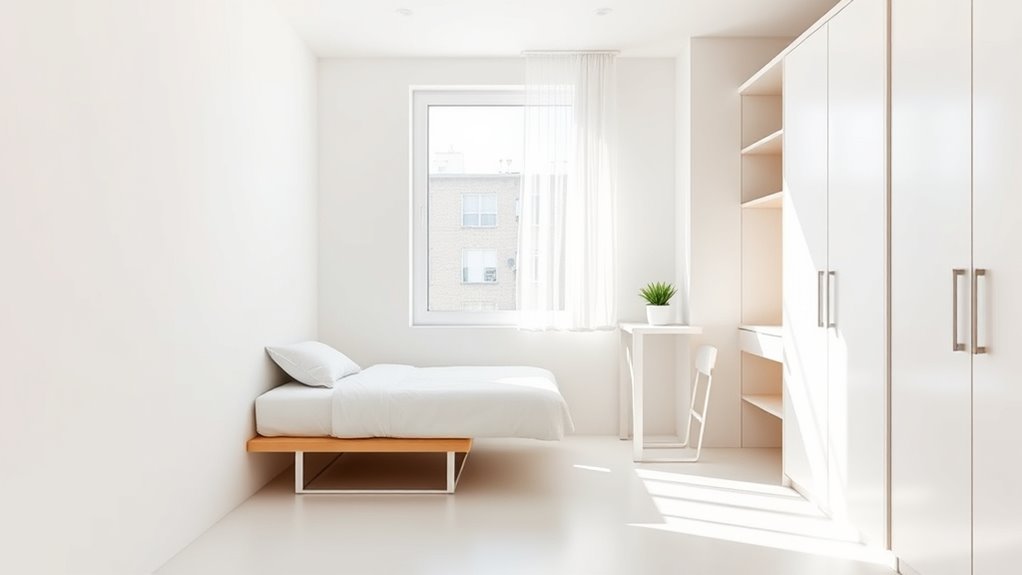Minimalism enhances tiny living by helping you make the most of limited space through decluttering and smart storage solutions. It encourages you to prioritize what truly matters, creating a calm and organized environment. Space-saving furniture and hidden compartments keep your home feeling spacious and functional. By focusing on quality over quantity, you’ll enjoy less stress and more freedom. Keep exploring to discover more ideas on how minimalism can transform your small home into a sanctuary.
Key Takeaways
- Minimalism creates a calmer, more organized environment that maximizes limited space in tiny homes.
- It promotes intentional living, helping residents prioritize essentials and reduce clutter.
- Space-saving furniture solutions make tiny homes more functional and feel more spacious.
- Rethinking storage with built-in and hidden options maintains a clean, open aesthetic.
- Adopting a minimalist mindset reduces maintenance, minimizes impulse buying, and supports long-term well-being.

Have you ever wondered if living with less can actually bring more freedom and happiness? Embracing minimalism in a tiny home might be the answer. When you simplify your space, you open up new opportunities for comfort and clarity. One of the keys to making this work is choosing space-saving furniture that maximizes every inch without sacrificing functionality. These pieces are designed to serve multiple purposes, such as a sofa bed or a fold-out dining table, which helps you maintain a clutter-free environment. Not only do they make your tiny home feel more spacious, but they also reduce the need for excess possessions.
Getting rid of unnecessary items is equally essential. Decluttering techniques come into play here, guiding you on how to evaluate what truly adds value to your life. Start by sorting your belongings into categories: keep, donate, sell, or discard. Be honest about what you use regularly and what just takes up space. Minimalism isn’t about deprivation; it’s about making intentional choices and creating a home that reflects your priorities. As you declutter, you’ll notice your environment becomes calmer and more organized, which naturally promotes peace of mind. Additionally, adopting a minimalist mindset can help you sustain these habits over the long term.
Creating a minimalist lifestyle in a tiny home also involves rethinking your storage solutions. Instead of bulky cabinets and cluttered shelves, opt for sleek built-in storage options that blend seamlessly into your space. Hidden compartments, under-stair drawers, and furniture with integrated storage help you keep your belongings out of sight but easily accessible. With less visual clutter, your tiny living space feels more open and inviting. This not only improves functionality but also reduces stress, making daily living more enjoyable.
Living minimally in a small home encourages you to prioritize quality over quantity. You’ll learn to select versatile, durable items that truly serve your needs. This approach eliminates impulse buys and reduces clutter accumulation, freeing up mental space as well. The minimalist mindset fosters intentional living, where every possession has a purpose. As a result, maintaining your tiny home becomes easier because there’s less to clean, organize, and worry about. You find joy in a well-organized, thoughtfully curated environment that supports your lifestyle and personal growth.
In the end, embracing minimalism in tiny living isn’t just about fitting everything into a small space — it’s about creating a home that energizes and inspires you. Through space-saving furniture and decluttering techniques, you gain freedom from excess and gain clarity. You discover that less truly can be more, allowing you to focus on what truly matters and enjoy a more intentional, fulfilling life.
Frequently Asked Questions
How Does Minimalism Impact Mental Health in Tiny Homes?
Minimalism positively impacts your mental health by boosting emotional well-being and reducing clutter. When you embrace minimalism, you create a calmer, more organized space that minimizes stress and distractions. Less clutter means fewer visual chaos and mental overload, helping you feel more relaxed and focused. As a result, your tiny home becomes a sanctuary where clarity and peace flourish, making daily life more manageable and enjoyable.
What Are Common Challenges Faced When Adopting Minimalism?
You might find that adopting minimalism is challenging because clutter management requires constant effort, and storage solutions can feel limited. It’s true that letting go of possessions can be emotional, making it tough to prioritize what’s essential. You need discipline to resist accumulating unnecessary items and creativity to maximize space. Embracing these challenges helps you develop better organization habits, ultimately making tiny living more manageable and fulfilling.
Can Minimalism Improve Financial Stability in Tiny Living?
Yes, minimalism can improve your financial stability in tiny living. By practicing financial discipline, you’ll spend less on unnecessary items and prioritize your needs. This approach helps you save more, leading to consistent savings growth over time. With fewer possessions, your expenses decrease, giving you better control over your finances. Ultimately, minimalism encourages smarter spending habits, making your tiny home lifestyle more affordable and financially secure.
How Do You Maintain Motivation for Minimalism Long-Term?
You stay motivated for minimalism long-term by making it a daily habit. Think of it as your secret superpower—fueling your life with purpose. Set clear, achievable goals that keep you inspired and track your progress. Celebrate small wins and remind yourself of the freedom minimalism brings. When you focus on the positive impact, your motivation grows stronger, making minimalism an effortless part of your lifestyle.
What Minimalism Strategies Work Best for Families in Tiny Spaces?
You should prioritize space-saving furniture to maximize your tiny home’s functionality and keep clutter at bay. Involve your family in organization routines, creating designated spots for everything to maintain order. Simplify your belongings by regularly decluttering, and set shared goals to stay motivated. These strategies promote efficient use of space and foster teamwork, making tiny living comfortable and sustainable for your whole family.
Conclusion
By embracing minimalism, you’ll find that tiny living becomes more manageable and fulfilling. Some might worry it feels too limiting, but in reality, it opens up space for what truly matters—your passions, relationships, and peace of mind. When you declutter and simplify, you create a home that nurtures your well-being. So, don’t let the fear of losing possessions hold you back—minimalism can truly transform your tiny home into a sanctuary of freedom and joy.









